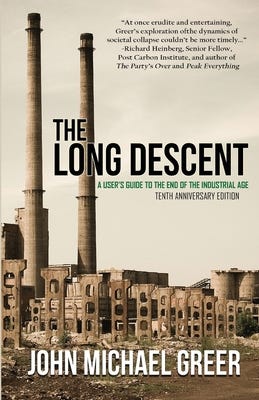Explaining bad climate politics with the Marvel Cinematic Universe
An environmental argument against the false choice between Billionaires vs. Ecofascist Finger-Snappers
In last week’s column about how misanthropy is a choice, I mentioned the existence of a subreddit page called “Thanos Did Nothing Wrong,” in which hundreds of thousands of people joined and enthusiastically agreed with the genocidal villain from the Marvel Cinematic Universe. It occurred to me that Thanos vs. The Avengers actually nicely illustrate the two most popular — and most castrophic — approaches to climate change and ecological collapse in the modern world.
Thanos, if you haven’t seen the movies, spends several films acquiring immensely powerful “Infinity Stones,” which enable him to snap his fingers and kill half of all living things in the universe. He does this because he believes that overpopulation leads to suffering, and that by killing half of all living things, he is bringing balance back to the universe’s ecosystems.
Thanos is opposed — and eventually defeated — by the Avengers, the alliance of Marvel superheroes that the film series centers around. The Avengers, it’s worth noting, are about as problematic as Thanos is. They have two core leaders: one, Tony Stark, is a billionaire arms manufacturer who develops an AI which attempts to exterminate all human life, the other, Captain America, is a supersoldier developed by the American military industrial complex, who violently resists global attempts to regulate his ability to act with impunity.
When looking at the problems with how humans are approaching climate change, Thanos and the Avengers pretty perfectly embody our two worst approaches: Thanos is a perfect example of the “ecofascist” approach to environmentalism. And the Avengers are the perfect embodiment of the “progress” approach. Let’s dig in, shall we?
The Thanos Approach: Paul Ehrlich and third-world sterilization
In the 1960s and 70s, it started to become undeniable to those paying attention that humanity’s ongoing industrialization and economic growth was having negative effects on the global environment.
In 1968, the biologist Paul Ehrlich published what was probably the second most influential (behind Silent Spring) science book of the 60’s: The Population Bomb. In it, Ehrlich argued that human population growth was proceeding far too rapidly, and that in the coming decades, the world would see catastrophic levels of famine, with hundreds of millions dying globally.
The solution, Ehrlich argued, was for governments to undertake drastic efforts to try and curb population growth as quickly as possible. To do so, he advocated for widely available contraceptives, public sex education, and universal access to abortion1.
He also argued that governments should add temporary sterilants to the public water supply, cut off food aid to countries undergoing famine, and only offer financial aid to countries that mandated sterilization for men with over 3 kids2.
Ehrlich was a charismatic speaker, and over time, his ideas became en vogue among a certain set of the global elites, and some countries aggressively, even coercively, pursued Ehrlich’s recommendations. This meant that many poor countries forced women to abort pregnancies they did not wish to terminate, and that in others, men were forcibly sterilized.
The problem — if it isn’t blazingly, horrifically obvious — is that this population control campaign is effectively genocidal against poorer, less developed countries in the global south. Which also just happen to be non-European, non-white countries. This is what has come to be dubbed as ecofascism, and it’s alarmingly high in the (white) American environmentalist community.
These countries also happen to be the ones that are the least responsible for the pressures being placed on the global environment. In another blockbuster 1972 book, The Limits to Growth, the argument was made that the earth could not sustain endless population and economic growth. The argument (sensibly) being that a planet with finite resources cannot sustain infinite growth. Or, as the environmentalist Edward Abbey put it:
Growth for the sake of growth is the 'ideology' of the cancer cell.
The distinction is an important one, because while Ehrlich wasn’t wrong that earth can’t sustain an infinite number of humans, that population growth is also tied closely to the economic growth that has come with the spread of both global industrialization and global capitalism. And the blame for the economic direction that the earth has taken over the past couple of centuries lies squarely on the shoulders of the people in the global north. Who the population doomers simply weren’t interested in targeting, because they didn’t have as many babies.
What’s so silly about the Ehrlich/Thanos3 approach to environmental problems is that it punishes a whole lot of people/lifeforms that quite simply aren’t to blame for any pressures placed on the environment. The Thanos Snap is ridiculous because his snap destroyed half of all life in the universe. One of the number one signs of a healthy ecosystem is abundant, diverse life. What puts pressure on an ecosystem is when one species begins destroying everything else, by harvesting, mining, and extracting more than it puts back in, and by driving other species to extinction.
Likewise, it’s not humans that are the disease in Ehrlich’s calculation, it’s the economic and political system which treats nature as something to be exploited and dominated, rather than lived within. The proof for this is in that large swathes of humanity have managed to live sustainably for hundreds of thousands of years. This current global system — which began in earnest with the Industrial Revolution two centuries ago — just happens to exactly coincide with our global growth problems.
What’s more, population in a society in decline tends to correct itself — the writer John Michael Greer points out in his book The Long Descent that:
Russia is a good model here; since the collapse of Communism, it’s seen rising death rates and falling birth rates to such an extent that the population will be cut in half by 2100, and yet there hasn’t been any massive catastrophe to account for this — simply shifts in statistics driven by economic and political failure.
Given that economic and political failure have already led to a massive drop in birth rates among millennials, it’s possible that we could stop worrying so much about sterilizing the “breeders” and instead start formulating economic systems that bring us back into harmony with nature.
The Avengers Approach: Do nothing, leave it to the Supermen
There’s a second approach to climate that is also based on dangerous fantasy, and it’s nicely represented by the Avengers. The Avengers, like all superheroes, are übermenschen. The übermensch was a Nietzschean idea about a certain type of man who would evolve beyond normal mankind, and thus would be above normal human morality. This idea appealed to the Nazis, who decided that they were the more evolved man, and that they could treat everyone else as subhuman.
Superman, the very first superhero — whose name is just a translation of the German word übermensch — was an attempt at subverting these ideas, made by two 18-year old Jewish kids from Cleveland. What if, they asked, this superhuman instead of treating other people like chattel, used his powers for good, for truth, justice, and the American way?
The problem is that after the initial subversion, the writers behind superheroes largely ignored the general problem with the übermensch ideology, and instead embraced it: their heroes were billionaires, genius scientists4, and literal mutants who had evolved past normal humans. And because of these abilities, the heroes were largely allowed, in their universes, to be above the law, acting as vigilantes. They frequently served right-wing causes, allying with the police to fill prisons with incurable criminals5, and allying with the American military-industrial complex in acts of espionage and war.
In this universe, the solution to all problems comes from innovation and genius. The thousands — if not millions — who are killed when the Superhumans fight (whether it’s Superman vs. Zod in Metropolis, Batman vs. Joker in Gotham, or Ozymandias vs. New York City in Watchmen) are inconsequential. They are narrative devices and side characters in a story about battling Gods.
These narratives rarely countenance the idea of these superhumans exercising restraint, and when they do, the idea is eventually discounted as the reluctant hero is called back into battle.
This, obviously, is the approach most Americans have decided to take in regards to problems around the climate: leave it to the smart people to save us. The idea is that if we allow the geniuses to innovate enough, we can find solutions to climate that will allow us to not change our extractive economy. Of course, many of the people our country has chosen as its Titans are either vainglorious morons (in the case of say, Elon Musk) or are genuinely evil (in the case of Donald Trump or Peter Thiel) and have no interest in the lives of lowly regular humans such as ourselves. Their ideas, usually, are to either leave us all to die on this planet while they flee to Mars, to engage in risky geoengineering projects to “correct” the negative effects of climate change by, among other things, turning the blue sky white, or to build fortresses for the rich and slums for everyone else.
A third way: Humility
The uniting thread in both of these approaches to dealing with our current massive problems around climate is just a staggering lack of humility. In each scenario, certain special people take on the responsibility for fixing the planet, and in doing so, condemn millions of people of their choosing to death.
But in order to adapt to and mitigate the worst effects of climate change, we’re going to need much more than certain special individuals: we’re going to need entire communities that work together to figure out problems, and which can quickly adapt and change course as needed. This means people will need to put their egos at the door and focus on solutions rather than on either becoming or submitting to saviors.
It’s worth noting that if we’re talking about the type of dynamic community that can respond to climate change, we’re not talking about communism, at least not in the sense that it was applied in much of the world in the 20th century. New ideas, dissent, and the ability to abandon systems that haven’t been working are vital for any future our society has, which means that we’ll have to build something much more democratic than we have now in the US.
Regardless, our future’s challenges will be immense, and we’ll need all hands on deck. We cannot wait for heroes and villains to make the decisions for us.
So far so good!
…not as good!
If we’re really gonna credit the guy who invented this approach, we should call out the OG ecofascist, Thomas Malthus, who argued against charity and the existence of the welfare state because — to use the words of one Ebeneezer Scrooge (pre-haunting, of course) — it would be better for them to just die “and decrease the surplus population.”
In Alan Moore’s superhero comics spoof “What We Can Know About Thunderman,” the Stan Lee character is pressured by the CIA to have his superheroes powers come from radiation, as a way of rebranding nuclear power, nuclear weapons, and the very negative public image of what radiation poisoning actually did to the human body.
The idea that some people are just incurably criminal is a popular belief in the racist ideology of eugenics, which was a kind of flip side to the Nazi conception of the übermensch. In the United States, eugenics became extremely popular and was used as the justification for racist, discriminatory policies.






